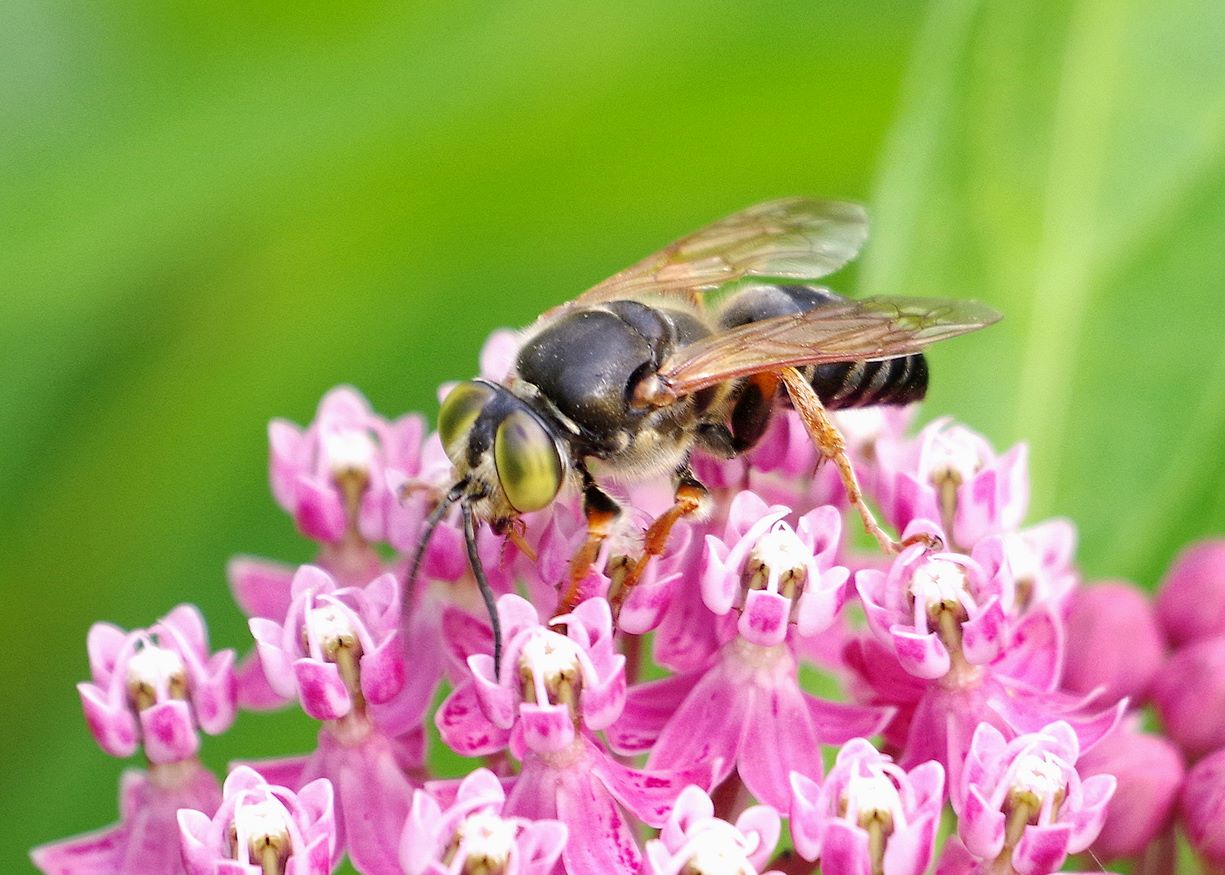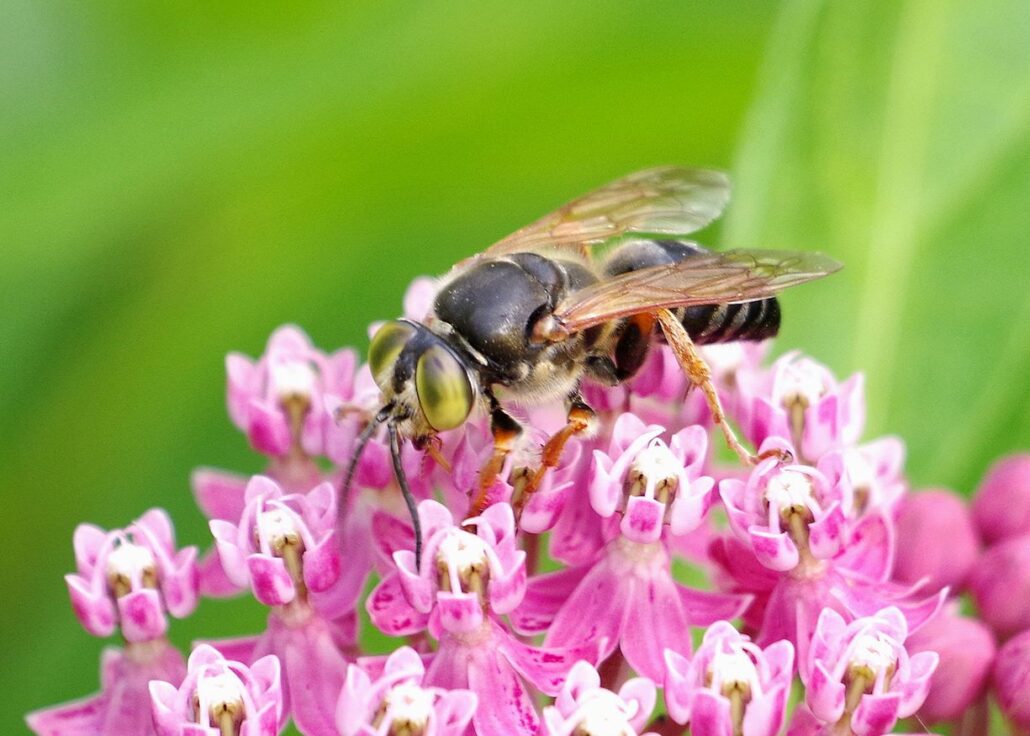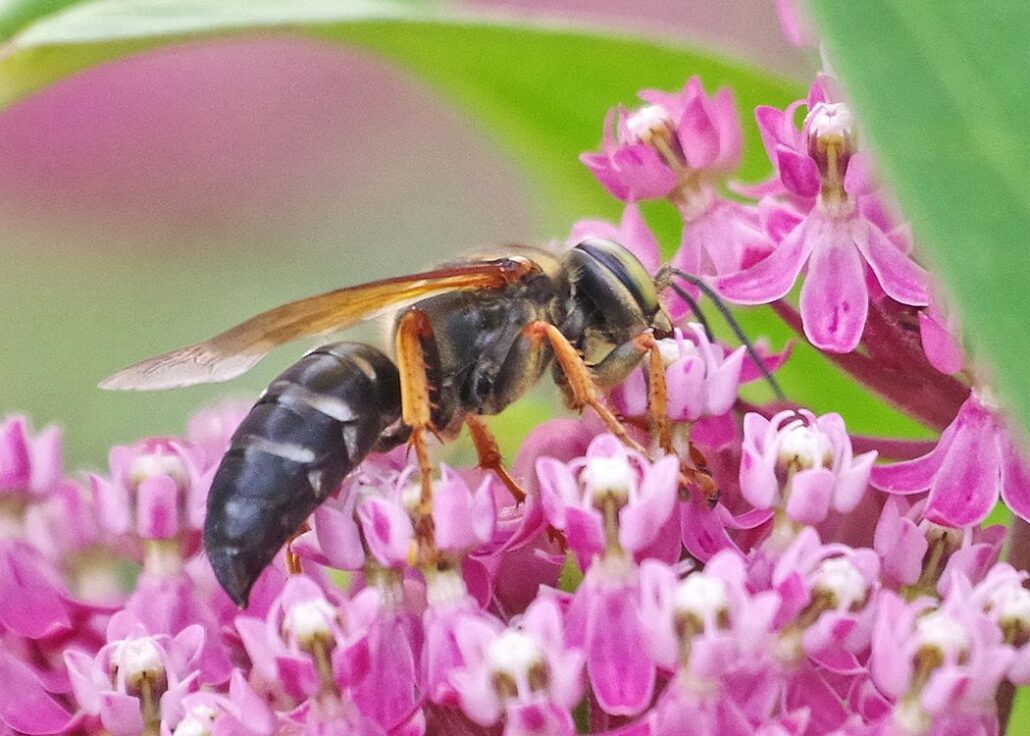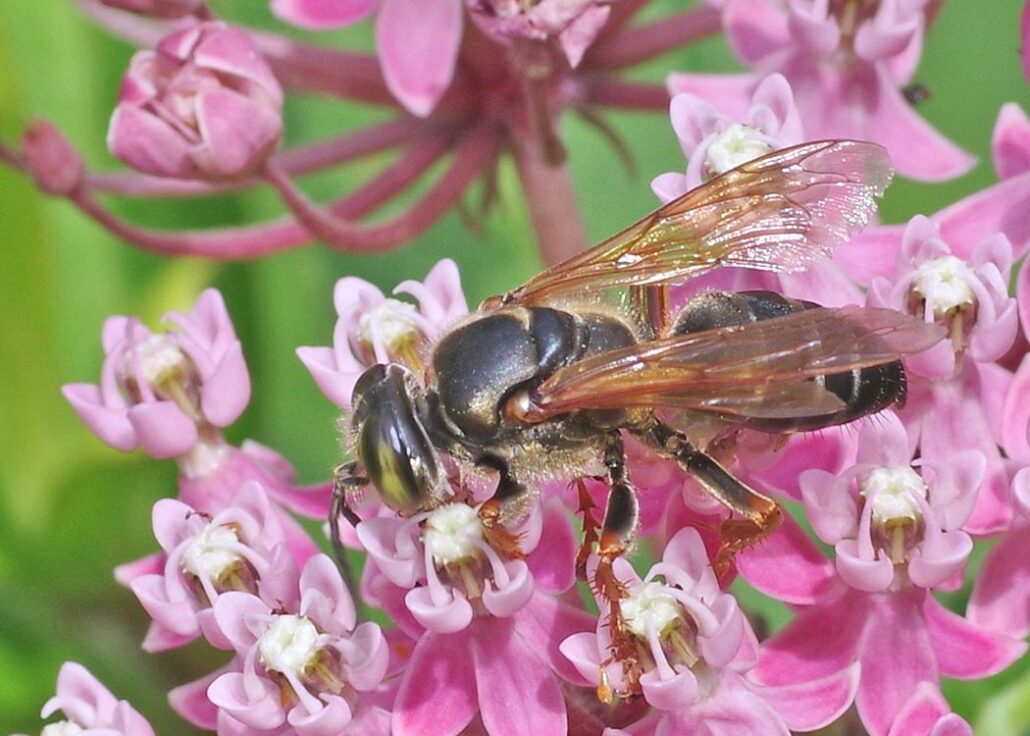
by Kate Redmond
Bug o’the Week Robust Katydid-hunting Wasp
Greetings, BugFans,
OK – it’s not a super flashy wasp when it’s heading away from you (in fact, it’s not even very wasp-like), but it’s pretty cool when it’s heading toward you – those eyes. And what an awesome name (though not quite as awesome as the related Eastern Ant-Queen Kidnapper Wasp)! Both species are in the Square-headed wasp family Crabronidae, a family that we have met in previous BOTWs. Here’s a quick reintroduction.
The family includes Square-headed (https://uwm.edu/field-station/square-headed-wasp/) and Sand wasps (https://uwm.edu/field-station/sand-wasps/) and the Organ-pipe mud daubers (https://uwm.edu/field-station/organ-pipe-mud-dauber/). It’s a large, diverse bunch (1225 species here; almost 9,000 worldwide) that was carved off of the now-much-smaller wasp family Sphecidae (the thread-waisted wasps) not too long ago (in taxonomists’ years).
What Crabronids have in common, besides some anatomical features concerning the size and/or shape of the inner margin of the compound eyes, of the pronotum (the part of the thorax right behind the head), of a lobe in the hind wing, and of the almost non-existent “wasp waist” – on such things are identities hung – is their habit of caching insect prey in underground egg chambers for their eventual larvae to eat/parasitize. A few species let other wasps do the hunting and then steal the results (kleptoparasitism). Many species are picky about both prey and nest sites, and adults feed on pollen and nectar.
Robust Katydid-hunting Wasps are one of 34 mostly-similar-looking species in the genus Tachytes in North America. Tachytes comes from a Greek word meaning “swiftness” or “speed,” and the genus is often called the Sand-loving wasps because of their preference for nesting in sandy soil types. In his bugeric blog, entomologist Eric Eaton says they should be called the Green-eyed wasps. The combination of their size, somewhat stout build, and scattering of short hairs makes some people (like the BugLady) mistake them for bees at first glance.
Females tunnel from 3 inches to almost 3 feet into the ground, creating side tunnels and scooping out cells in the walls, and she provisions these cells chronologically, deepest first (shorter tunnels may contain only a single cell). The genus specializes in grasshoppers, katydids, pygmy crickets and mole crickets. Says Eaton, the “Female paralyzes the victim with her sting, then straddles it, grasps it by the antennae with her jaws, and flies it back to her nest. There she deposits her prize in one of the cells.” Researchers Evans and Kurczewski say that “many of the larger species emit a high-pitched buzz when flying with prey…..”
While she’s provisioning a cell, a female may stash some bodies in a chamber inside the entrance temporarily.



ROBUST KATYDID-HUNTING WASPS (Tachytes crassus) are found from the Midwest through Canada and New England, plus several states in the Southeast. They measure a shade longer than a half-inch, with green eyes and mostly caramel-colored legs. Here are some glamour shots from bugguide.net: https://bugguide.net/node/view/1277906, https://bugguide.net/node/view/778850/bgimage. Heather Holm, in her magnificent Wasps: A Guide for Eastern North America says that females have three silver bands on their abdomen and males have four.
According to Eaton, male Tachytes wasps emerge before females and often are more numerous. They set up small territories near burrows where they expect females to appear, but after the females emerge, the males move their territories to nesting areas and nectar sites. In some Tachytes species, the courtship is brief – he pounces on her back and pins her wings and then waves his antennae frantically in front of her face to soften her up https://bugguide.net/node/view/1013235.
Females often dig their tunnels near those of other females. Holm writes that “Tachytes crassus usually nests in sand although Evans and Kurczeski (1966) found a nesting aggregation in clay-loam soil. Female excavates a deep, angled multicellular nest, then deposits soil around the burrow entrance, forming a tumulus. The female may or may not leave the nest open while away hunting for prey. When returning with prey to an open nest entrance, she flies directly into the nest without hesitation, clutching her prey beneath her.” Holm quotes the eminent French Naturalist Jean Henri Fabre (1921) “The Tachytes clears the entrance to the home and goes in alone. She returns, puts out her head and seizing her prey by the antennae, warehouses it by dragging backwards.” Please take the time to read some of Fabre’s lovely account of the genus https://www.gutenberg.org/files/3462/3462-h/3462-h.htm#link2HCH0007.
Holm continues, “She hunts for prey close to the ground in tall grass, meadows, or prairies where grasshoppers occur…..prey caught earlier in the growing season may be all nymphs; prey caught later in the season and later in the female’s life (cached in the upper cells) are more likely to be adults. Between five and ten prey are provisioned in each cell. A single egg is laid between the foreleg and midleg on one of the prey at the bottom of the cell.”
RKHWs are common on Swamp milkweed flowers (Asclepias incarnata). One would think that a swamp milkweed lover would also be a major swamp milkweed pollinator, but a study in 2003 by Ivey, et al, indicated that while the RKHW was a frequent visitor to the flower, it “was the poorest at removing, carrying, then subsequently transferring pollinia to other swamp milkweed flowers.” Remember, pollination is an accidental, not an intentional act, and milkweed pollinia are saddlebag-shaped and sticky (see the legs of the dangling bee caught by the almost-invisible ambush bug). Like RKHWs, Thynnid wasps (Myzinum sp.) https://bugguide.net/node/view/1958377/bgimage are frequent visitors with a similar active, random foraging style, and yet they were far more effective pollinators. What took them only six or seven flower visits to accomplish (removing and then inserting a pollinium) took some RKHWs up to 500 visits.
Kate Redmond, The BugLady
Bug of the Week archives:
http://uwm.edu/field-station/category/bug-of-the-week/
